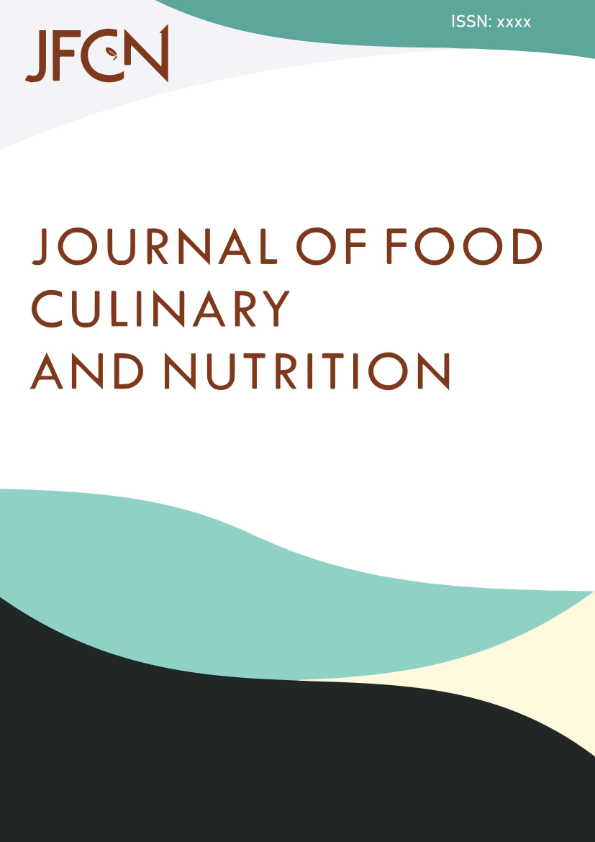Quality of Tea Fermented Drink from Natural Fermentation of Banana (Musa paradisiaca) and Fuji Apple (Malus domestica)
Abstract
Keywords
Full Text:
PDFReferences
Anggraeni, L., Lubis, N., & Junaedi, E. C. (2021). Review: Pengaruh Konsentrasi Garam Terhadap Produk Fermentasi Sayuran. Jurnal Sains Dan Kesehatan, 3(6), 891–899. https://doi.org/10.25026/jsk.v3i6.459
AOAC. (2005). Official Methods of Analysis of the Association of the Official Analytical Chemist.
Arifan, F., Winarni, S., Wahyuningsih, Pudjihastuti, I., & Broto, R. T. D. W. (2019). Total Plate Count (TPC) Analysis of Processed Ginger on Tlogowungu Tourism Village. Proceedings of the International Conference on Maritime and Archipelago (ICoMA 2018), Advances in Engineering Research, 377–379.
Davidson, R. H., Duncan, S. E., Hackney, C. R., & Eigel, W. N. (2000). Probiotic Culture Survival and Implications in Fermented Frozen Yogurt Characteristics. Journal Dairy Science, 83, 666–673.
Ibrahim, S. A. (2016). Lactic Acid Bacteria: Lactobacillus spp.: Other Species. In Reference Module in Food Science. Elsevier. https://doi.org/10.1016/B978-0-08-100596-5.00857-X
Maftei, N. M., Raileanu, C. R., Balta, A. A., Ambrose, L., Boev, M., Marin, D. B., & Lisa, E. L. (2024). The Potential Impact of Probiotics on Human Health: An Update on Their Health-Promoting Properties. In Microorganisms (Vol. 12, Issue 2). Multidisciplinary Digital Publishing Institute (MDPI). https://doi.org/10.3390/microorganisms12020234
Nurhartadi, E., Nursiwi, A., Utami, R., & Widayani, E. (2018). Pengaruh Waktu Inkubasi Dan Konsentrasi Sukrosa Terhadap Karakteristik Minuman Probiotik Dari Whey Hasil Samping Keju. Jurnal Teknologi Hasil Pertanian, 9(2), 73–83.
Paray, A. A., Singh, M., & Amin Mir, M. (2023). Gram Staining: A Brief Review. International Journal of Research and Review, 10(9), 336–341. https://doi.org/10.52403/ijrr.20230934
Puspaningrum, D. H. D., Sumadewi, N. L. U., & Sari, N. K. Y. (2022). Karakteristik Kimia dan Aktivitas Antioksidan Selama Fermentasi Kombucha Cascara Kopi Arabika (Coffea arabika L.) Desa Catur Kabupaten Bangli. Jurnal Sains Dan Edukasi Sains, 5(2), 44–51. https://doi.org/10.24246/juses.v5i2p44-51
Rahayu, A. M., & Setiadi, A. E. (2023). Isolation and Characterization of Indigenous Lactic Acid Bacteria from Pakatikng Rape, Dayak’s Traditional Fermented Food. Jurnal Penelitian Pendidikan IPA (JPPIPA), 9(2), 920–925.
Rahmawati, F. D. N., Swasti, Y. R., & Purwijantiningsih, E. (2021). Kajian Pustaka: Kualitas Minuman Probiotik Berbahan Dasar Nabati dengan Variasi Sukrosa dan Bakteri Asam Laktat. Jurnal Ilmu Pangan Dan Hasil Pertanian, 4(2), 112–128. https://doi.org/10.26877/jiphp.v4i2.7466
Touret, T., Oliveira, M., & Semedo-Lemsaddek, T. (2018). Putative probiotic lactic acid bacteria isolated from sauerkraut fermentations. PLoS ONE, 13(9). https://doi.org/10.1371/journal.pone.0203501
Utami, C. R. (2018). Karakteristik Minuman Probiotik Fermentasi Lactobacillus Casei Dari Sari Buah Salak. In Jurnal Teknologi Pangan (Vol. 9, Issue 1).
Wulansari, N. D., Padmiswari, A. A. I. M., Gandamayu, I. B. M., Suryati, N. W. N., & Raningsih, N. M. (2022). Edukasi Masyarakat Tentang Potensi Minuman Probiotik Sari Buah Salak Bali (Salacca Zalacca) Sebagai Antibakteri Di Desa Sumerta Kelod. Jurnal Abdimas ITEKES Bali, 2(1), 68–72.
Yahia, E. M., Celis, M. E. M., & Svendsen, M. (2017). Fruit and Vegetable Phytochemicals: Chemistry and Human Health, 2nd Edition (E. M. Yahia, Ed.; 2nd ed.). John Wiley & Sons.
Yuan, X., Wang, T., Sun, L., Qiao, Z., Pan, H., Zhong, Y., & Zhuang, Y. (2024). Recent advances of fermented fruits: A review on strains, fermentation strategies, and functional activities. In Food Chemistry: X (Vol. 22). Elsevier Ltd. https://doi.org/10.1016/j.fochx.2024.101482
DOI: https://doi.org/10.24167/jfcn.v1i2.12524
DOI (PDF): https://doi.org/10.24167/jfcn.v1i2.12524.g3173
Refbacks
- There are currently no refbacks.
Copyright (c) 2025 Journal of Food, Culinary, and Nutrition
Online ISSN : 3063-4121 JFCN Stats








